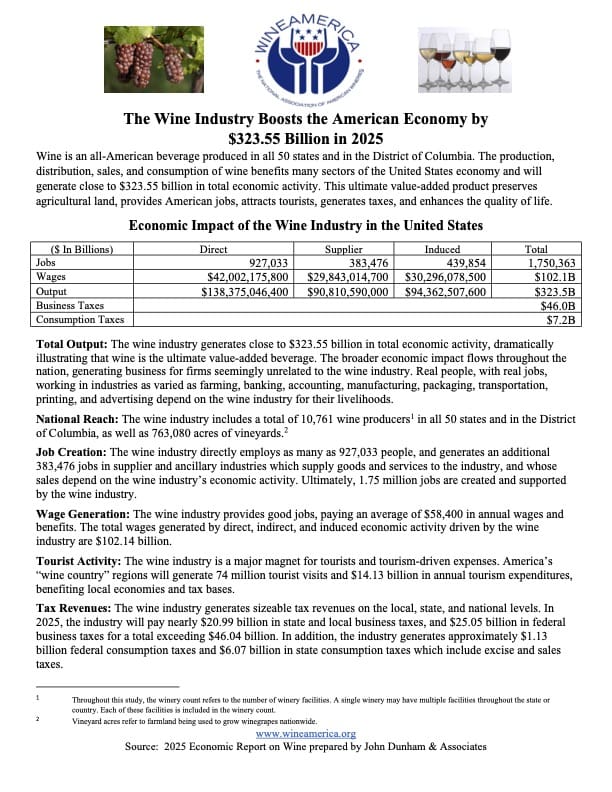Consumers love aroma, bouquet and taste. Legislators love jobs, wages and taxes.
By Jim Trezise
Wine is a magical beverage, but it’s also a robust economy. From the vineyard to the table, the wine economy is boosting the American economy with 1.75 million jobs, $102 billion in wages, $53 billion in taxes and $323 billion in total impact in 2025.

Today, the wine economy is our best protection as we enter a challenging new era. We need to tout wine’s worth, and WineAmerica already has the content for you to share.
Embracing the challenges
In the 43 years I’ve been in the wine industry, I’ve seen many challenges, but never so many major ones all at once: generational shifts, increased competition, cannabis legalization, climate change, global efforts to eliminate alcohol consumption, the whiplash of uncertainty surrounding tariff wars, potential changes to the Dietary Guidelines for Americans, major cuts in federal funding and employment, state-level tax increase proposals and so much more.
The first two require better marketing, while the rest involve public policy and the people who shape it. Each issue requires a specific response, but all of them can be buttressed by constant reminders of wine’s value to our economy at all levels.
Wine is a tasteful economic engine, the ultimate value-added product from vine to glass, which is produced and consumed (and taxed) in all 50 states. In 2025, the wine industry is boosting the American economy by more than $323 billion, including:
- 10,761 wine producers;
- 763,080 vineyard acres;
- 1.75 million jobs;
- $102.14 billion annual wages;
- 74 million tourist visits;
- $14.13 tourist expenditures;
- $53.24 billion total taxes;
- $26.16 billion federal taxes; and
- $27.07 billion state & local taxes.
The 2025 National Impact Study of the Wine Industry was sponsored by WineAmerica and conducted by John Dunham & Associates, a highly respected economic research firm specializing in public policy areas. Besides the three documents highlighting the key results, we always include the detailed Methodology and Frequently Asked Questions (FAQ) to be totally transparent. JDA also prepared similar studies for WineAmerica in 2017 and 2022.
Wine’s economic benefits come in three areas: Direct (production, distribution and consumption); Supplier (goods and services supporting the industry); and Induced (expenses in local businesses and communities). Here is the raw data:

Legislators and their staff don’t have time to make sense of all those numbers, so we’ve made it easy for them to understand with this press release.

And if they want a real quick view, here’s a handy infographic we created.

WineAmerica is the National Association of American wineries, with winery, association and supplier members from 46 states — which adds up to 92 U.S. Senators, including several in key leadership positions. We also have relationships with many key House members and work closely with the bipartisan Congressional Wine Caucus, co-chaired by Rep. Dan Newhouse (R-WA) and Mike Thompson (D-CA).
State stats
Given our status as a national organization, we insisted that our economic impact study includes the same detailed information for all 50 states. After all, much of the legislation and regulation governing the wine industry occurs on the state level. These data are available to everyone, not just WineAmerica members.
Not surprisingly, California derives the most economic benefit from wine, at $84.51 billion, followed by:
- Florida, $26,09 Billion
- Texas, $24.39B
- New York, $16.81B
- Illinois, $11.72B
- Washington, $10.56B
- Michigan, $8.96B
- Ohio, $7.70B
- Pennsylvania, $7.26B
- Oregon, $7.08B
Wait, what…?
How could Florida be second and Texas third, when Washington and Oregon are such major wine producers? Because of consumption, driven by population. This study, appropriately, measures everything from vine to glass. After all, if there wasn’t consumption, there would be no need for production.
Please Pass It On
So to get the three documents for your state, just go to this link to download them: put them on your website, embed them in your own computer and pass them on to your local, state and federal policy makers, regional media and colleagues in our wine community. The link also includes the three national documents and Methodology.
We at WineAmerica have shared these widely with federal legislators, as well as leadership at TTB and USDA, but they’re much more meaningful coming from you, the constituent. They’ll soon be on our website for easy access; meantime, please use these pieces to get the message(s) out.
We encourage you to send these state documents to both of your U.S. Senators, your member of Congress, governor, state legislative leaders, mayor and county executive, chamber of commerce and tourism agency — and anyone else you think may have sway.
Don’t wait until there’s a crisis, when they won’t have time to pay attention. Do it now, so they’ll have the knowledge they need in advance.
We are in the most challenging of times, but by working together and supporting each other, our wine community will grow and flourish.
Diversity is our Strength. Unity is our Power.
___________________________________________________________________________________________________

Jim Trezise
Jim Trezise is president of WineAmerica (WA), the only national wine industry association in the United States. WA is a 500-member strong organization that encourages the growth and development of American wineries and winegrowing through the advancement and advocacy of sound public policy. Membership is encouraged to support the important work of WA, which benefits all U.S. wineries.




